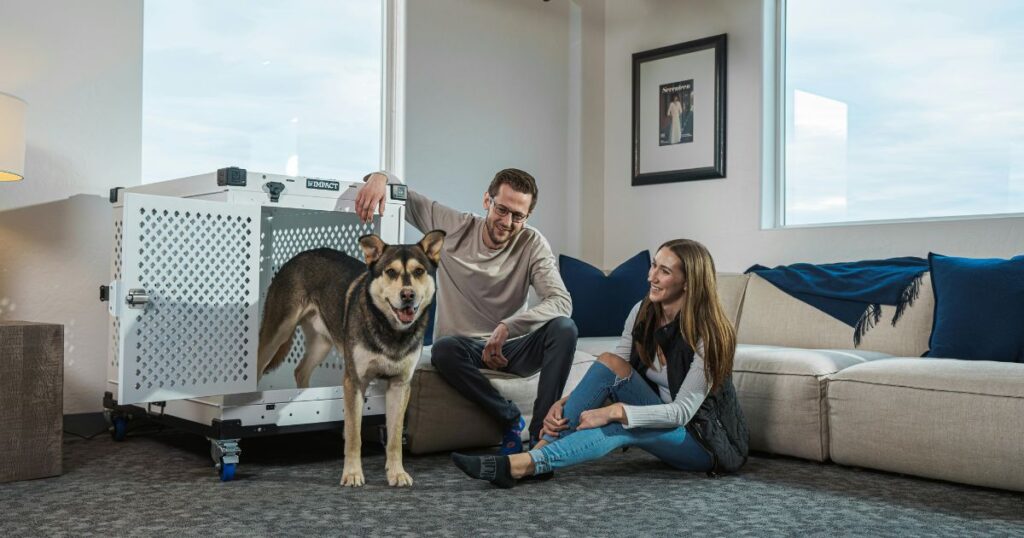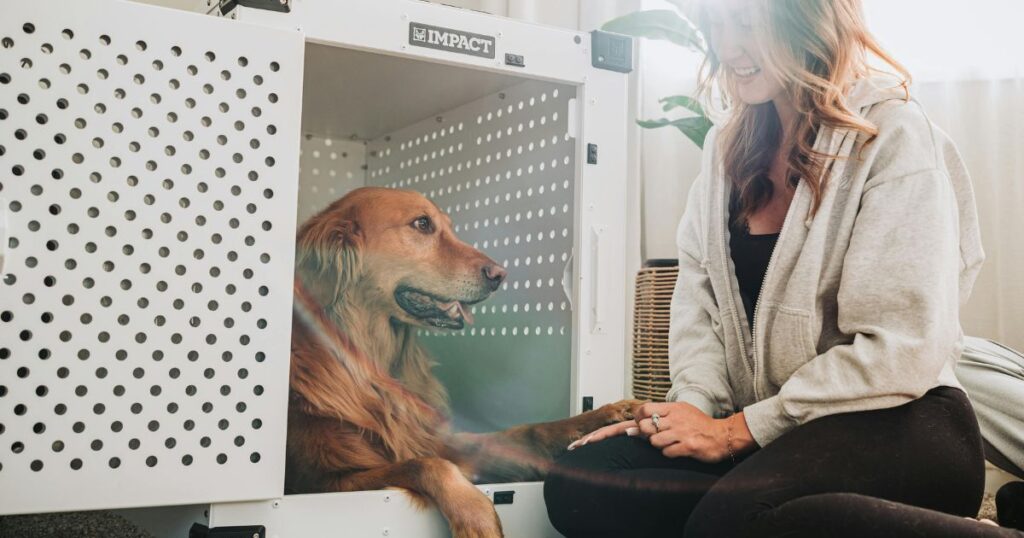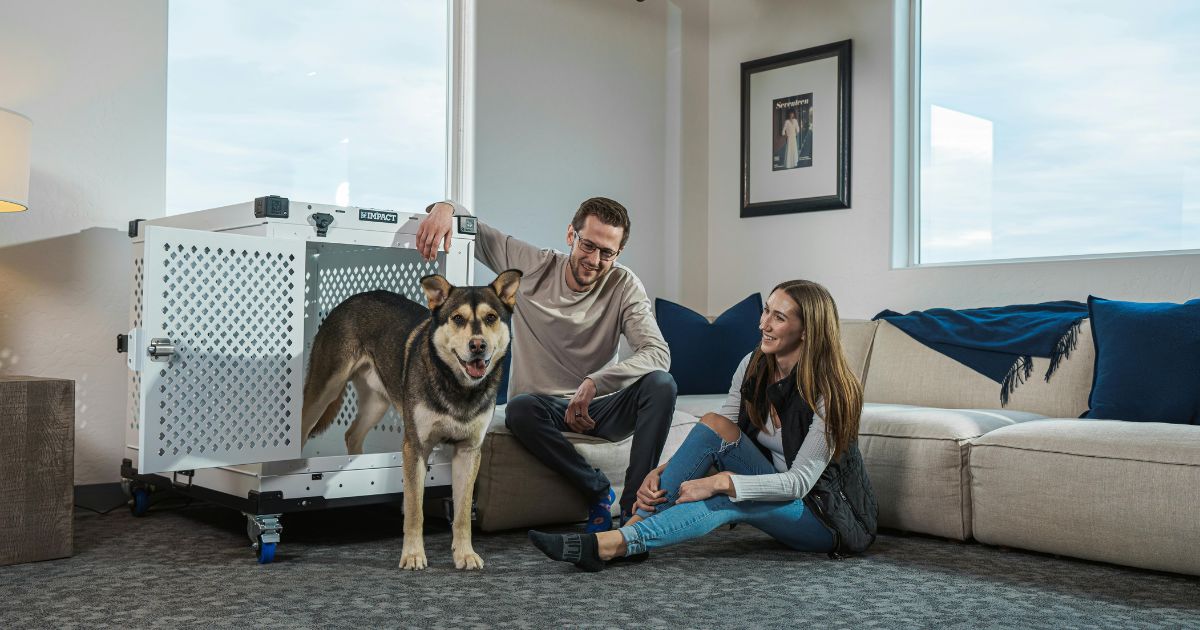As an Amazon Associate, I earn from qualifying purchases
Dog to Stop Peeing in Crate: By setting yourself a routine bathroom schedule, well-fitting the size of the cage can prevent your dog from peeing in it. Over the next few days, increase those periods with a lid and take your dog outside at lots regular of bouts.
One of the most challenging things you can deal with as a new pet owner is training your dog to stop peeing in their crate. This will take time, practice, and positive motivation. A dog often views his crate as a little personal den and housebreaking is the process of training.
A dog peeing in the crate is for several reasons such as anxiety, poor potty training or It could be that your crate is too big and they think they have enough room to pee without soiling their sleep area.

How to Stop Puppy From Peeing in Crate
To stop your puppy from peeing in the crate, it’s essential to create a consistent potty schedule and ensure the crate size is appropriate. A crate that’s too large allows your puppy to designate a spot for peeing, so choose one that fits their size or use a divider.
Make sure to take your puppy outside for potty breaks frequently, especially before crating, and limit water intake during crate time. We discuss in here, why puppies may pee in their crate and offer practical tips to prevent this behavior.
Importance Of Crate Training
Crate training offers multiple benefits for dogs and owners alike.
- Provides a haven for your dog to rest and relax.
- Assists with house training, as dogs naturally avoid soiling their den.
- Facilitates easier travel with a dog that’s accustomed to staying in a crate.
- Prevents destructive behavior when dogs are left alone at home.
Common Issues With Crate Training
| Issue | Description | Solutions |
|---|---|---|
| Accidents in Crate | Dogs may urinate in their crate due to various reasons. | Ensure frequent bathroom breaks and consider crate size. |
| Whining or Barking | Sign of anxiety or discomfort with the crate. | Gradual introduction to the crate and positive reinforcement. |
| Refusal to Enter Crate | Lack of positive association with the crate. | Use treats and toys to create positive experiences. |
Signs Of Distress
Recognizing when your dog is in distress is essential to address unwanted behaviors. Dogs, like humans, can feel stress, anxiety, and discomfort.
When they cannot express this verbally, they communicate through their actions. One such action that can indicate distress is when a dog starts peeing in their crate.
Recognizing Anxiety In Dogs
Anxiety in dogs can manifest in different ways. Signs to look for include:
- Pacing or restlessness
- Excessive barking or howling
- Shaking or trembling
- Hiding or avoiding people
- Chewing objects or self
- Drooling or panting more than usual
Subtle body language, like ears back and tail tucked, also signals anxiety.
Interpreting Peeing As A Stress Signal
When a dog starts peeing in their crate, it may not be a simple training issue but a stress response.
| Behavior | Possible Interpretation |
|---|---|
| Peeing in crate | Feeling insecure or threatened |
| Immediate urination after release | Overwhelmed or overexcited |
| Frequent, small amounts | Possible health issues or anxiety |
Understanding these stress signals can aid in finding the right solution to stop the unwanted behavior.
Proper Crate Size

Finding the right crate size is crucial for your furry friend’s comfort. It also helps in preventing accidents. A crate that’s too small or too big can lead to unwanted behavior, including peeing. Let’s explore how to size a crate correctly and understand its effects on your dog’s habits.
Sizing The Crate For Your Dog
Measure your dog’s length from nose to tail. Add 2-4 inches for the perfect crate length. Your dog should stand without hitting the top. They should turn around easily too.
Here’s a quick guide to help you:
| Dog Size | Crate Size (inches) |
|---|---|
| Small (up to 25 lbs) | 24″L x 18″W x 19″H |
| Medium (up to 40 lbs) | 30″L x 19″W x 21″H |
| Large (up to 70 lbs) | 36″L x 23″W x 25″H |
| Extra Large (up to 90 lbs) | 42″L x 28″W x 30″H |
Ensure to follow these crate size recommendations for a happy and comfortable pooch.
Impact Of Crate Size On Accidents
A crate that’s too large gives dogs space to pee at one end and sleep at the other. This can make house training tough. You want to avoid this.
On the other hand, a cramped crate is not only uncomfortable but can cause stress. Stressed dogs often have more accidents.
- Right size: Prevents peeing out of stress or habit.
- Cozy fit: Encourages dogs to hold it till they get outside.
- House training aid: The perfect size crate can make training easier.
Choose the perfect fit. Watch accidents reduce. Enjoy having a happier dog!
Establishing A Routine
Training your dog to stop peeing in the crate starts with a consistent routine. Dogs thrive on predictable schedules, which help them learn when and where to relieve themselves.
Let’s delve into the specifics of creating a solid routine to help your furry friend.
Creating A Consistent Schedule
Consistency is key in dog training. Set specific times for your dog to eat, play, and go potty. A dog’s internal clock is precise and sticking to these times daily is crucial.
- Wake-up potty break: First thing in the morning
- Post-meal: 15-30 minutes after eating
- Pre-bed: Last thing before sleep
Remember to take them out after naps and during playtimes as well.
Benefits Of Timely Feeding And Potty Breaks
Diligent feeding and potty breaks have several benefits:
- Reduces accidents
- Promotes healthy digestion
- Builds strong habits
Feed two to three times a day at the same time to prevent hunger unpredictability. Your dog will begin to expect when to eat and, in turn, when to use the bathroom.
Positive Reinforcement
Dogs learn best when they are rewarded for doing the right thing. Positive reinforcement is about giving your dog something they love.
This could be treats, praise, or play. When you reward your dog for not peeing in the crate, they begin to understand what you want.
Rewards For Desired Behavior
As soon as your dog does their business outside the crate, celebrate their success! Here are some tips to make this work:
- Be quick: Give the reward right after your dog pees outside.
- Be consistent: Reward them every time they get it right.
- Be varied: Mix up treats, cuddles, and playtime to keep your dog eager.
Create a schedule for bathroom breaks. Stick to it. This helps your dog understand when and where to pee.
Avoiding Punishment To Reduce Anxiety
Anxiety might lead to more accidents. Instead, clean up quietly. Use an enzyme cleaner to remove the smell. This stops your dog from thinking the crate is a bathroom spot.
| Do | Don’t |
|---|---|
| Use positive words when they do well. | Scold them for accidents. |
| Give a treat after peeing outside. | Give attention to the accident. |
Keep your dog’s crate time short. Increase it slowly. Make sure the crate is comfortable. Add their favorite blanket or toy. A cozy crate is a crate a dog won’t want to pee in.
Crate Comfort
Crate comfort plays a pivotal role in ensuring your furry friend feels secure and happy. A cozy crate encourages positive associations.
Let’s make the crate a sanctuary for your dog, not a place of stress. Follow these steps to help stop your dog from peeing in its crate.
Making The Crate Inviting
The good crate management part is what turns that crate into a safe space rather than a jail your dog wants to avoid. Start by selecting a good-quality crate in the right size. Can create to small or large feel uncomfortable and cause your dog to become destructive.
Set the cage where it will be out of the main traffic areas but still visible in your family, like a quiet corner. Make sure it is away from direct drafts, but not too insulated.
- Proper Ventilation: Good airflow prevents stuffiness.
- Soft Lighting: Gentle light soothes. Avoid harsh lights.
- Accessible: Keep the door open. Let your dog explore.
- Consistent Placement: Don’t move the crate. Stability is key.
Toys And Bedding Essentials
Comfortable bedding and familiar toys can make a world of difference. Opt for a soft, absorbent bedding that is easy to clean. Ensure that it’s the right size for the crate, providing a warm and plush surface.
| Item | Purpose |
|---|---|
| Durable Chew Toys | Keeps dogs busy and satisfied. |
| Comfortable Bedding | Creates a cozy resting place. |
| Favorite Blanket | Adds a layer of security. |
Rotate toys to maintain interest. Always remove any item if it becomes a hazard or excessively soiled. Remember, a crate that feels like home reduces anxiety and accidents.
Medical Concerns
Underlying medical concerns can cause this distressing issue. It’s important to first eliminate any health problems.
Rule Out Health Issues
Dogs don’t naturally soil the area where they sleep. If they start doing so, it could point to health issues. Look out for symptoms like frequent urination, blood in urine, or crying when peeing.
Keep track of your dog’s behavior and any signs of discomfort. This information can be valuable when consulting with a veterinarian.
When To Consult A Veterinarian
Consult a vet if you notice:
- Changes in urination habits
- Signs of pain or discomfort
- Unusual pee color or smell
t’s essential to make an appointment as soon as these signs appear. A timely diagnosis can lead to quicker resolution and may prevent more serious issues.
Remember, your furry friend relies on you to stay happy and healthy. Don’t hesitate to seek professional advice.
Proper Cleaning Techniques
Ensuring that the crate remains spotless discourages fur babies from reoffending. Here’s a step-by-step guide to effectively clean the crate after accidents, without using harmful cleaners.
Cleaning The Crate After Accidents
Immediate action is vital after discovering an accident in the crate.
- Remove your dog and bedding from the crate.
- Wear gloves to protect your hands from bacteria.
- Blot up as much urine as possible with paper towels.
- Rinse the crate with warm water to dilute the urine residue.
- Apply a pet-safe cleaner, and scrub the area thoroughly.
- Rinse again and let the crate air dry completely.
Avoiding Ammonia-based Cleaners
Ammonia-based cleaners can attract dogs back to the spot.
- Look for “ammonia-free” on cleaner labels.
- Use vinegar and water as a natural cleaning solution.
- Choosing enzymatic cleaners can help neutralize odors.
Regular cleaning keeps the crate a no-go zone for accidents.
When To Seek Professional Help
Sometimes, at-home methods might not solve the problem. It’s essential to know when to call in a pro.
Professional help can turn things around. Recognize when you’ve done all you can alone. It’s okay to seek extra support for you and your furry friend.
Behavioral Trainers For Persistent Issues
Behavioral trainers are a crucial resource for stubborn cases. They bring expertise and experience that you may lack. Dogs that persistently pee in their crates might have deeper issues. A specialist can uncover these. Here’s when to consider a trainer:
- Regular crate accidents despite training.
- No medical reasons behind the behavior.
- Signs of anxiety or stress when crated.
A good trainer will work with you. They tailor strategies for your dog’s specific needs. This means more effective training!
Understanding When Professional Training Is Needed
Professional training helps beyond crate issues. It sets up your dog for overall better behavior. You might wonder when to seek a trainer’s help. Consider these points:
- If your efforts don’t stop the peeing.
- When your routine doesn’t calm your dog.
- If there’s a sudden change in your dog’s habits.
Seek professional training as a step to success. Your dog deserves a happy, stress-free life. With the right assistance, every pet can achieve good crate behavior!

Conclusion
By implementing these strategies, you can successfully stop your puppy from peeing in the crate. Patience, consistency, and positive reinforcement are key to crate training success and helping your puppy develop good bathroom habits.
Remember, persistence is key to a pee-free crate!
As an Amazon Associate, I earn from qualifying purchases

